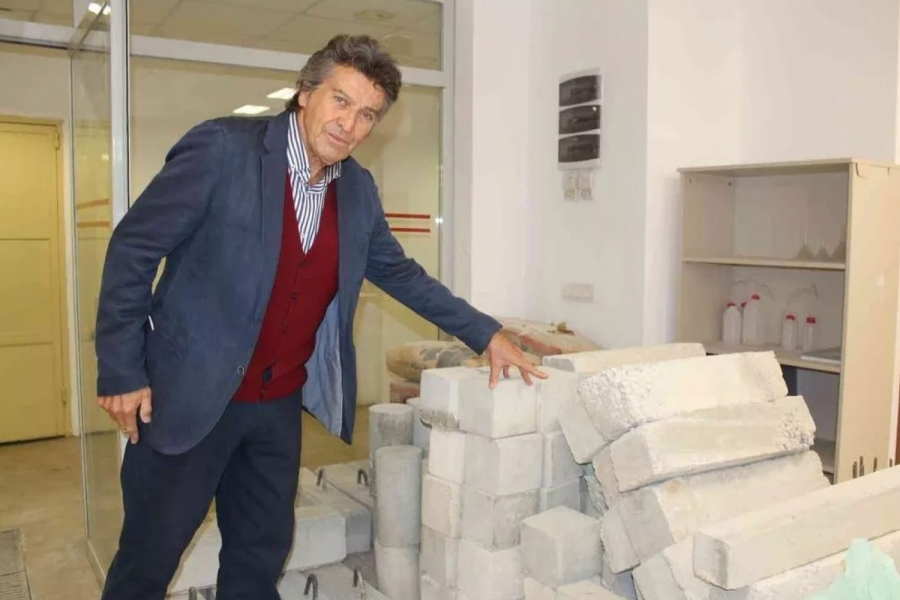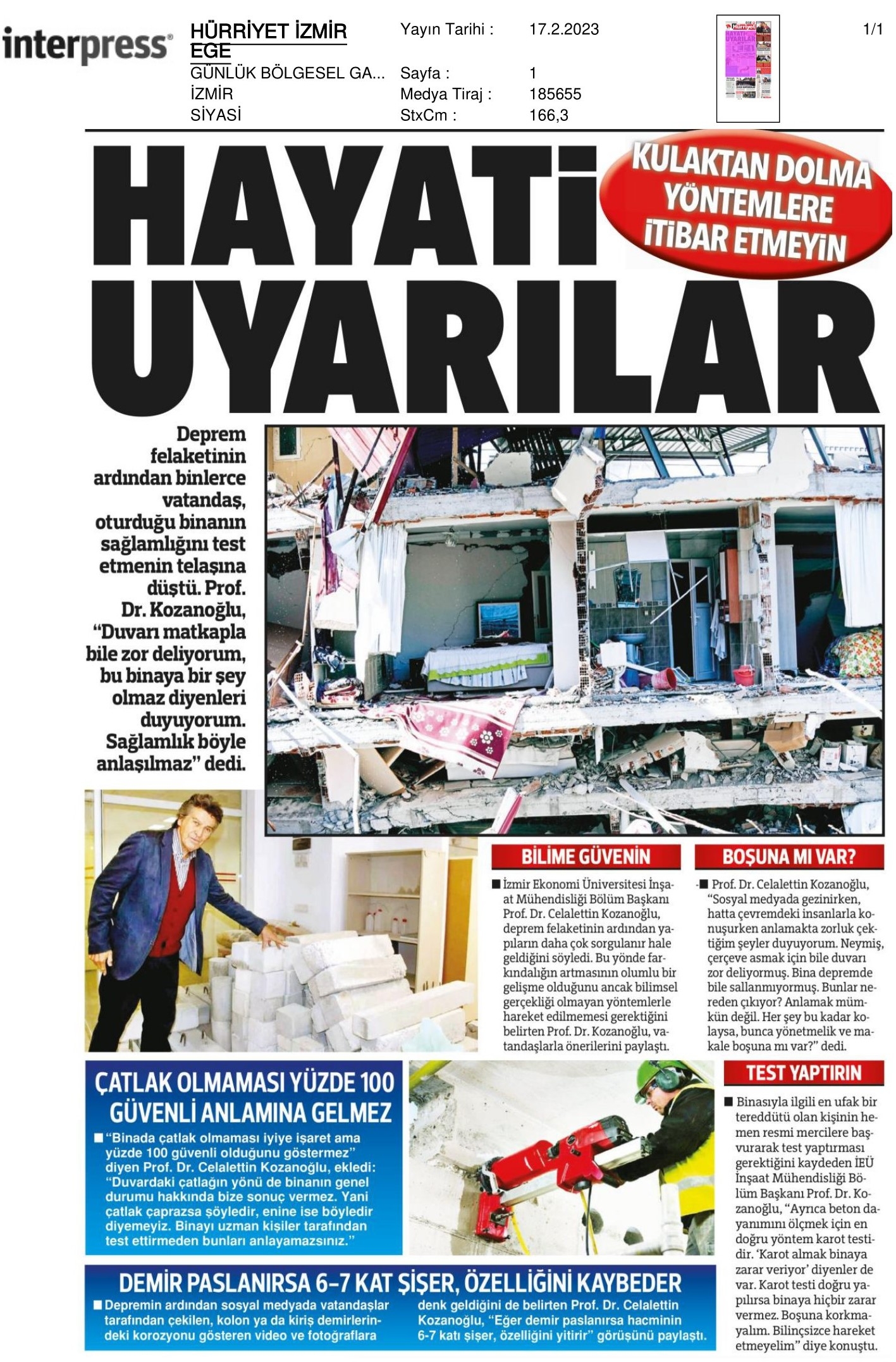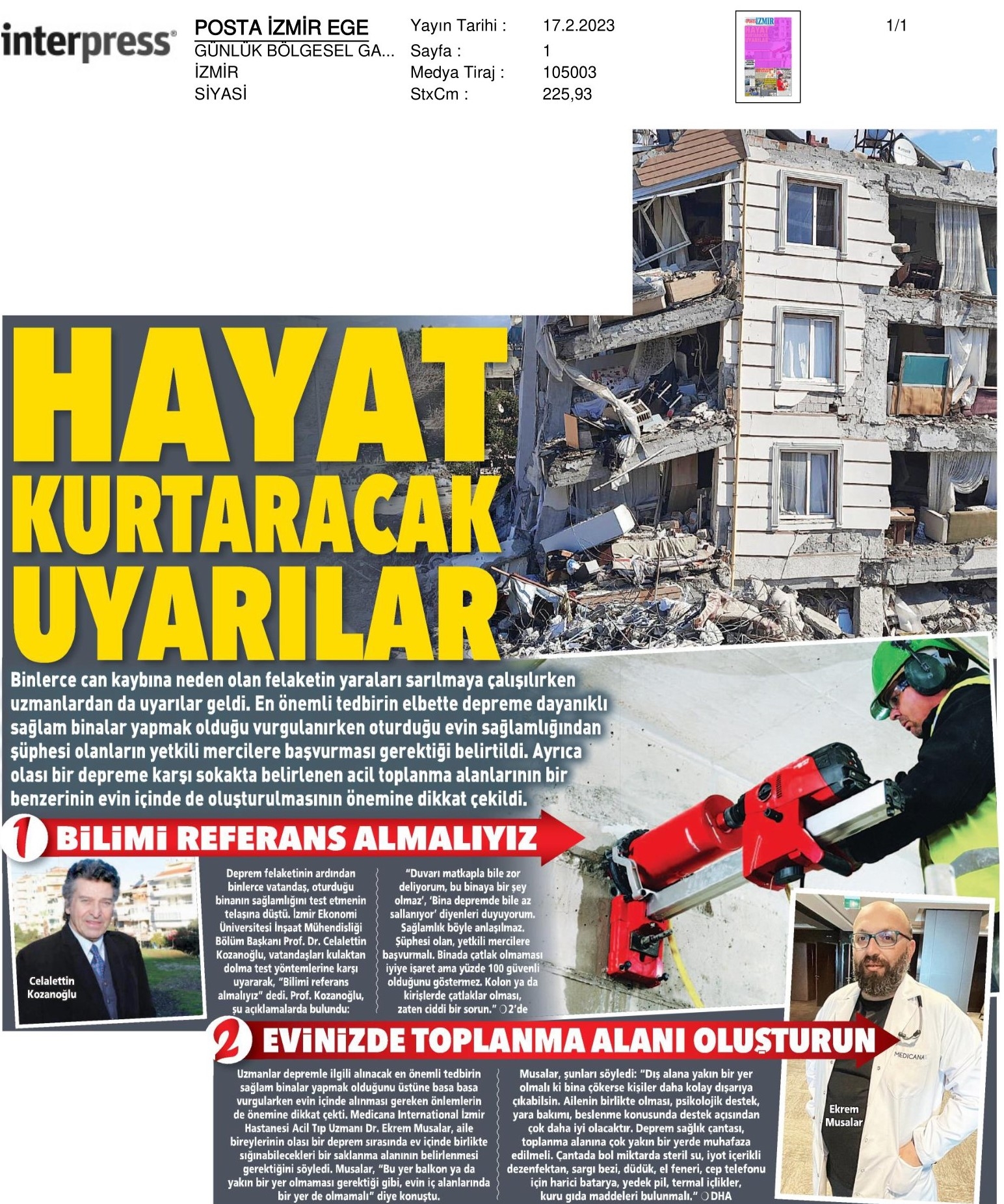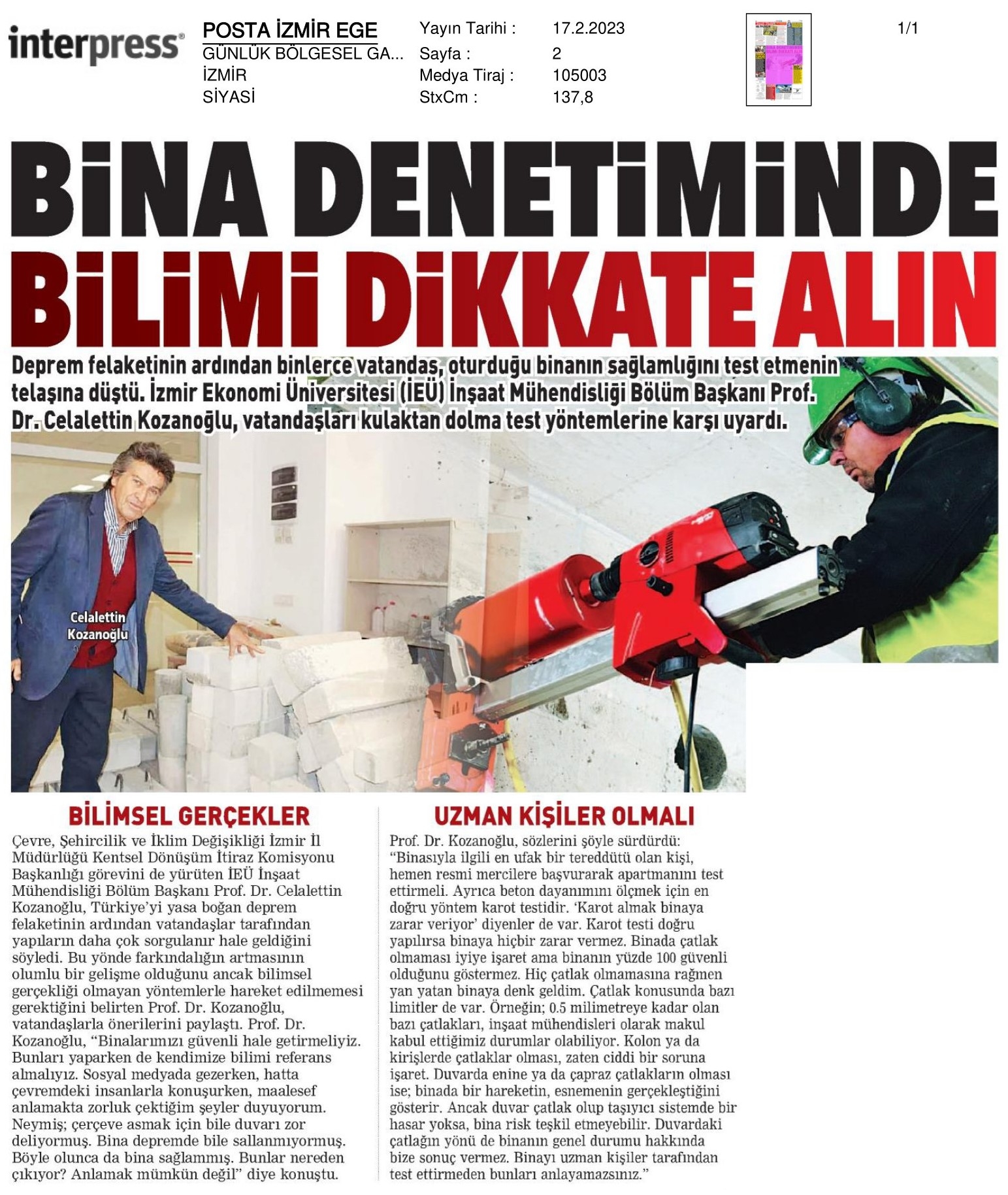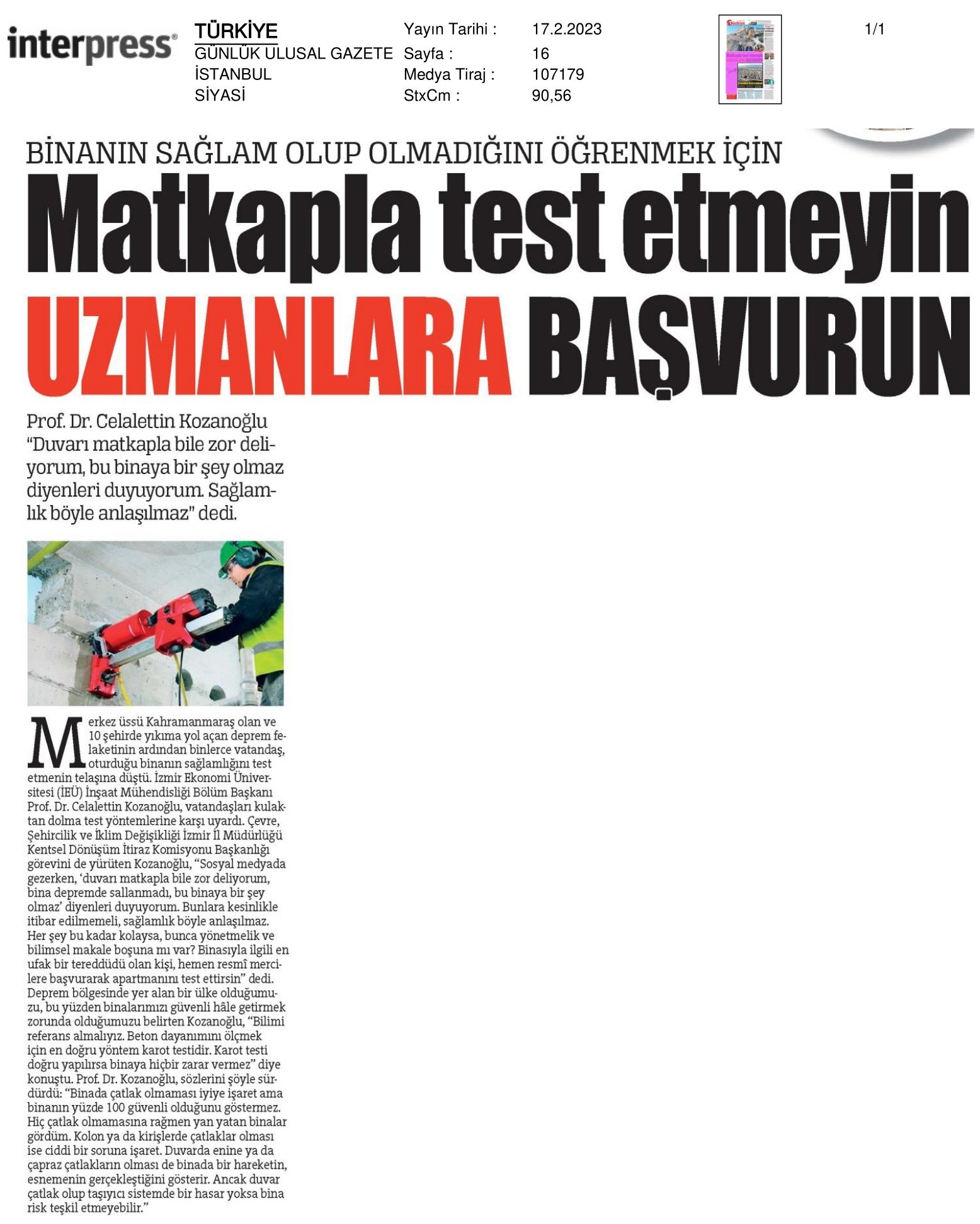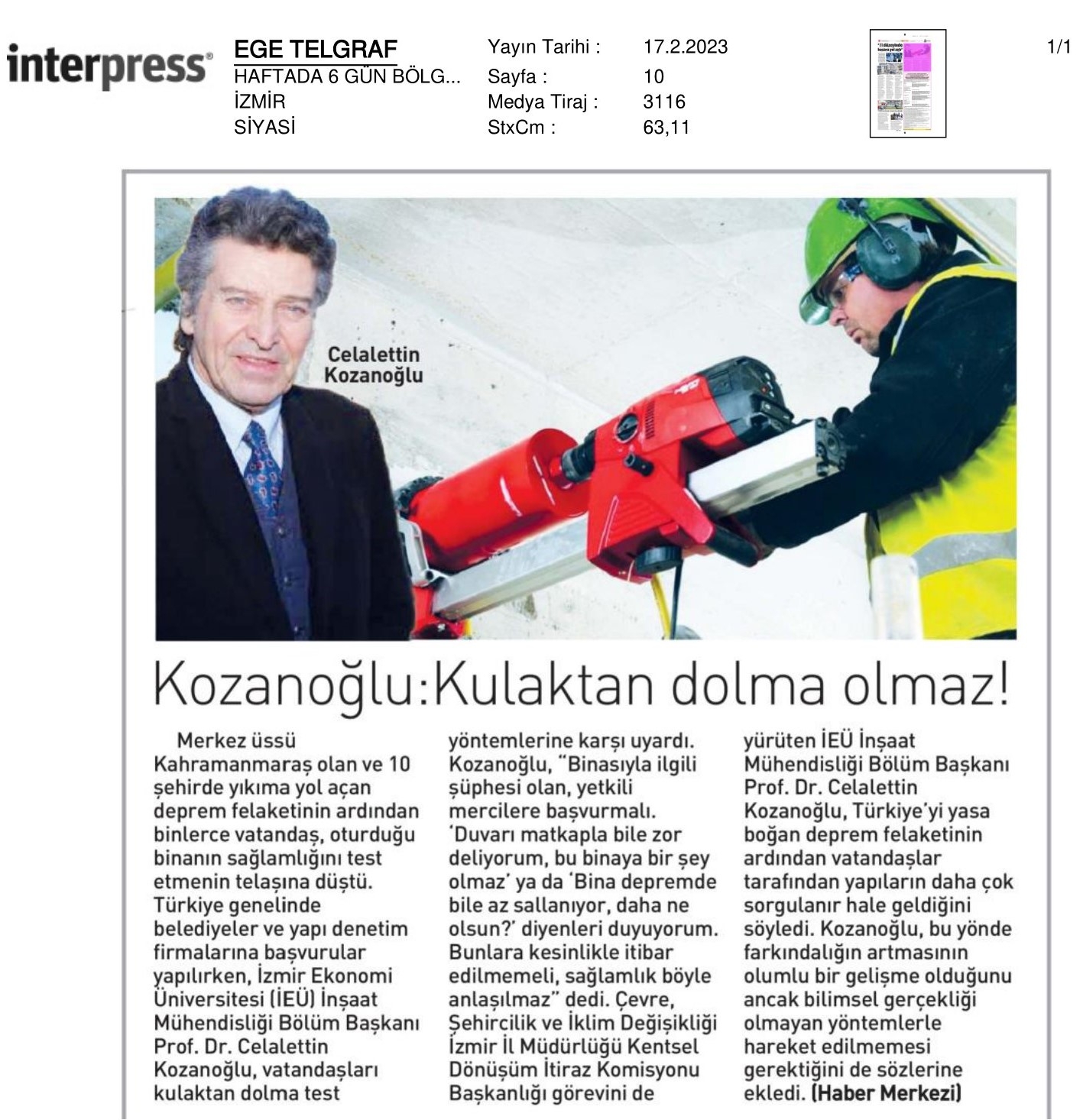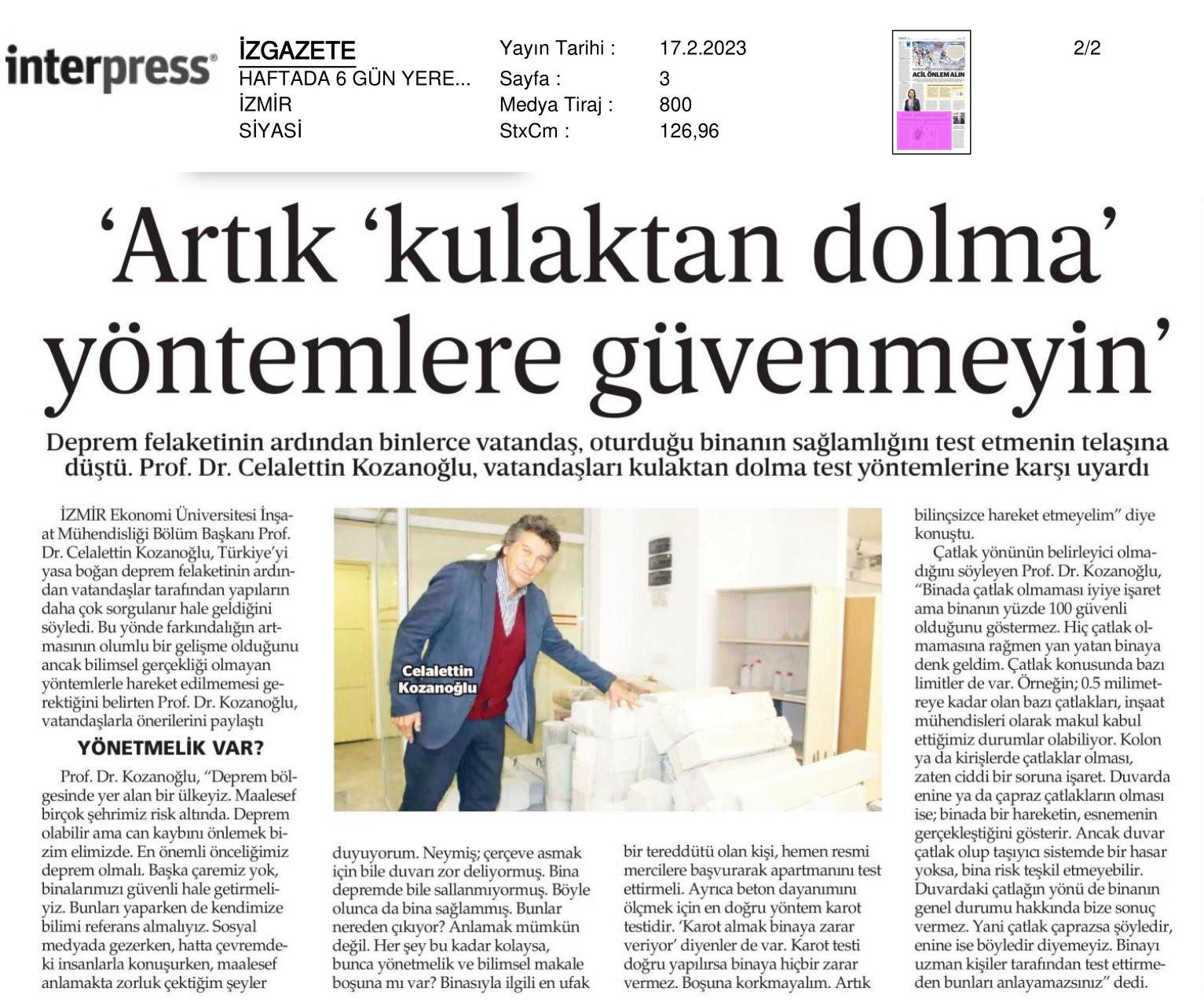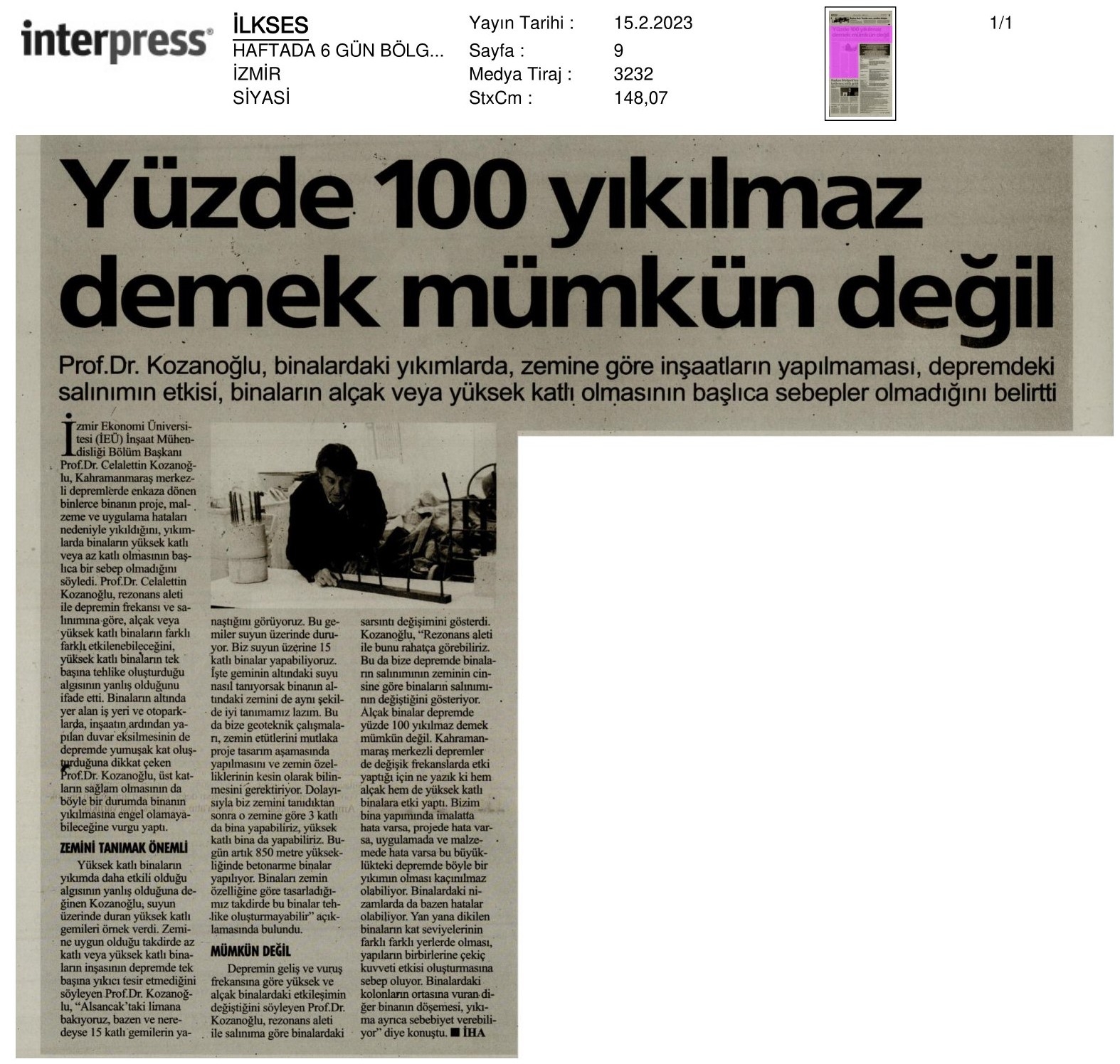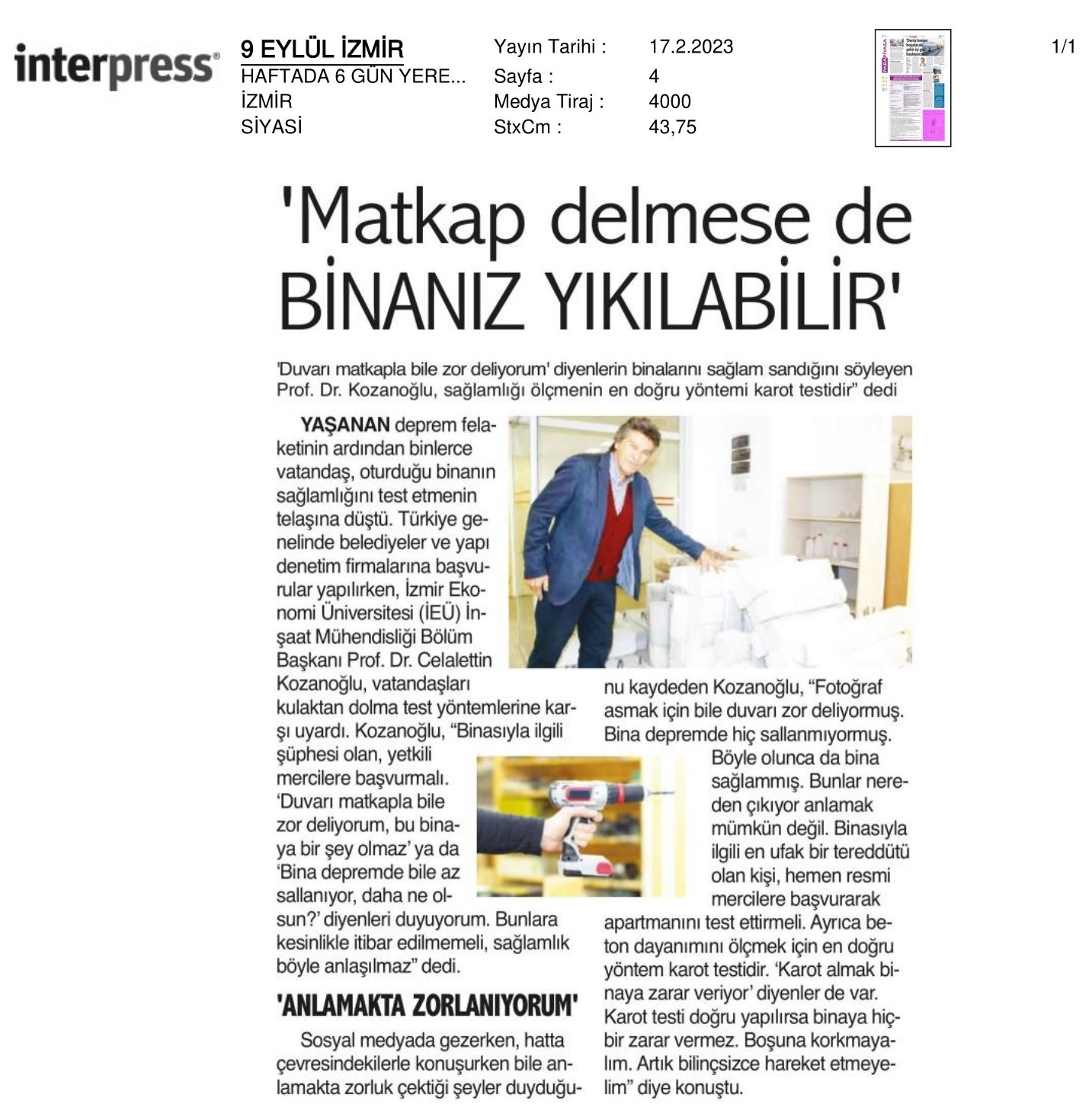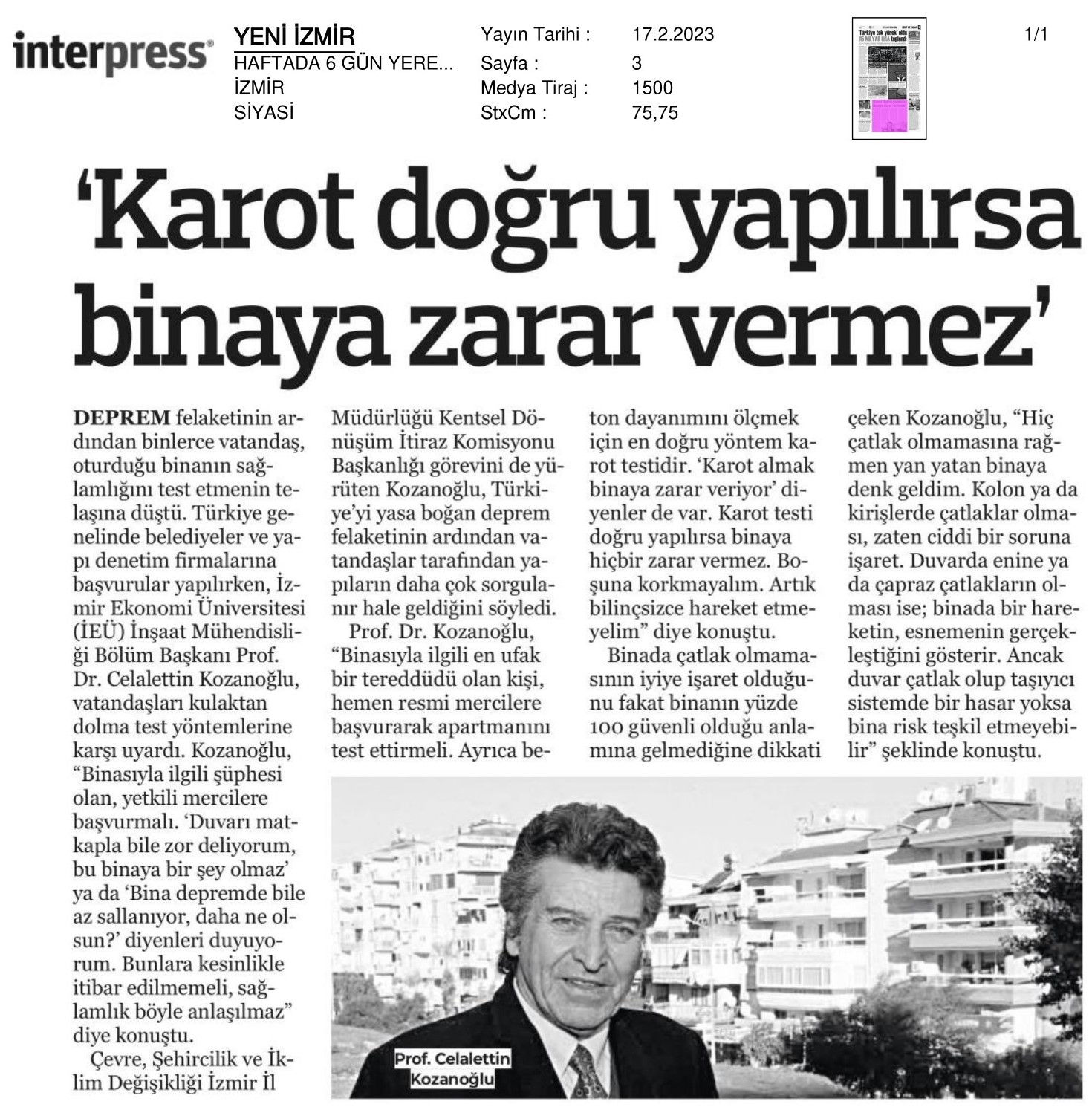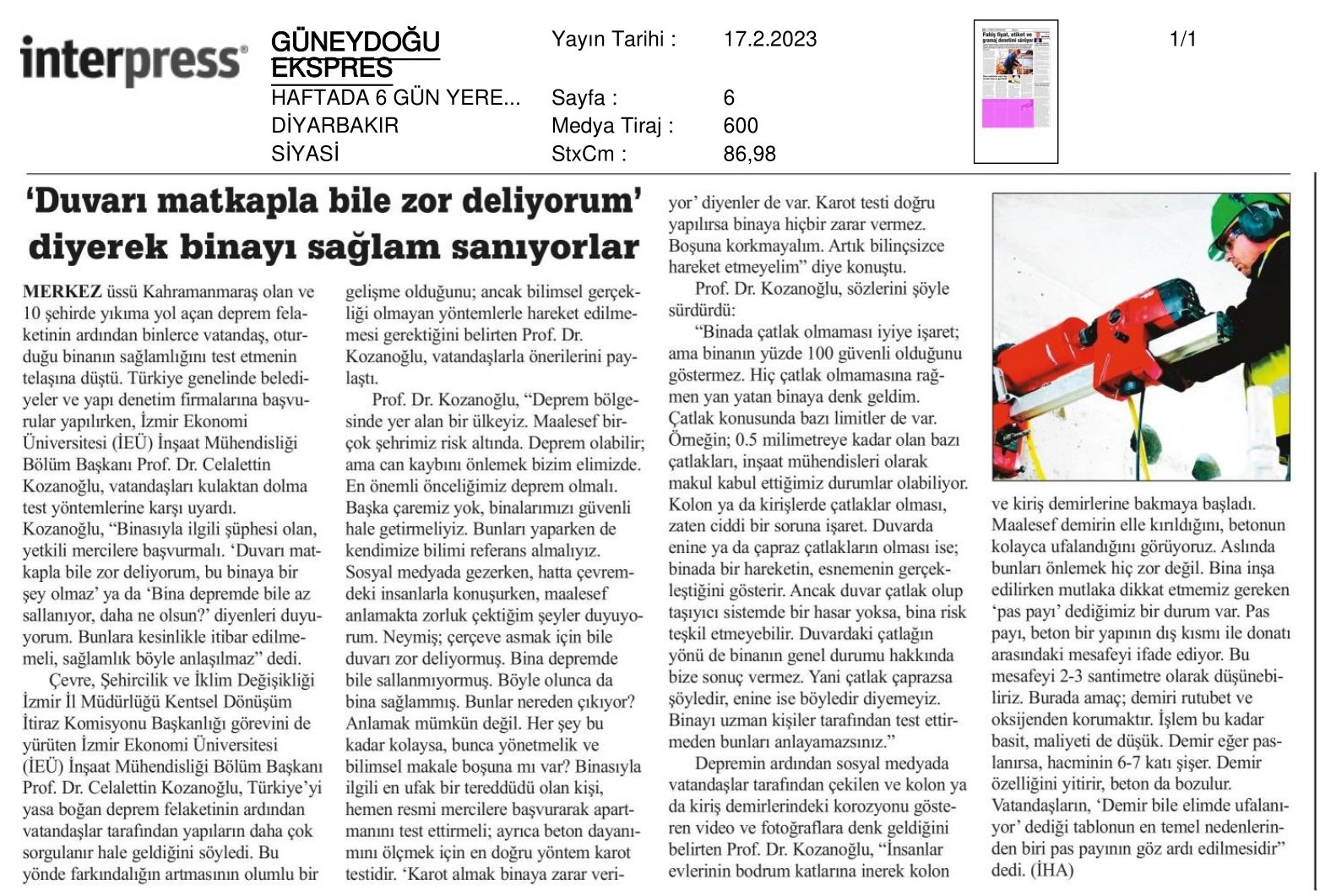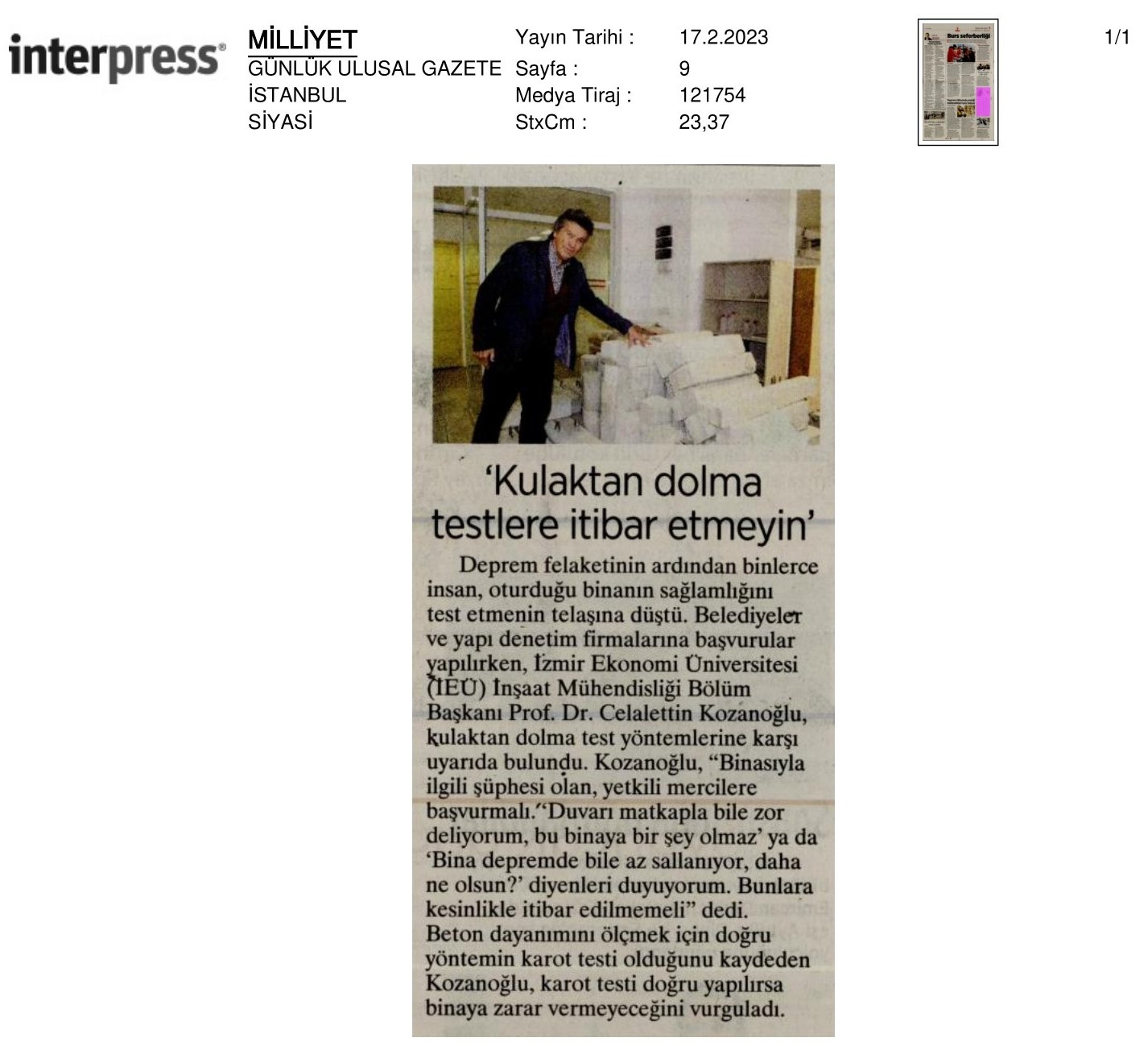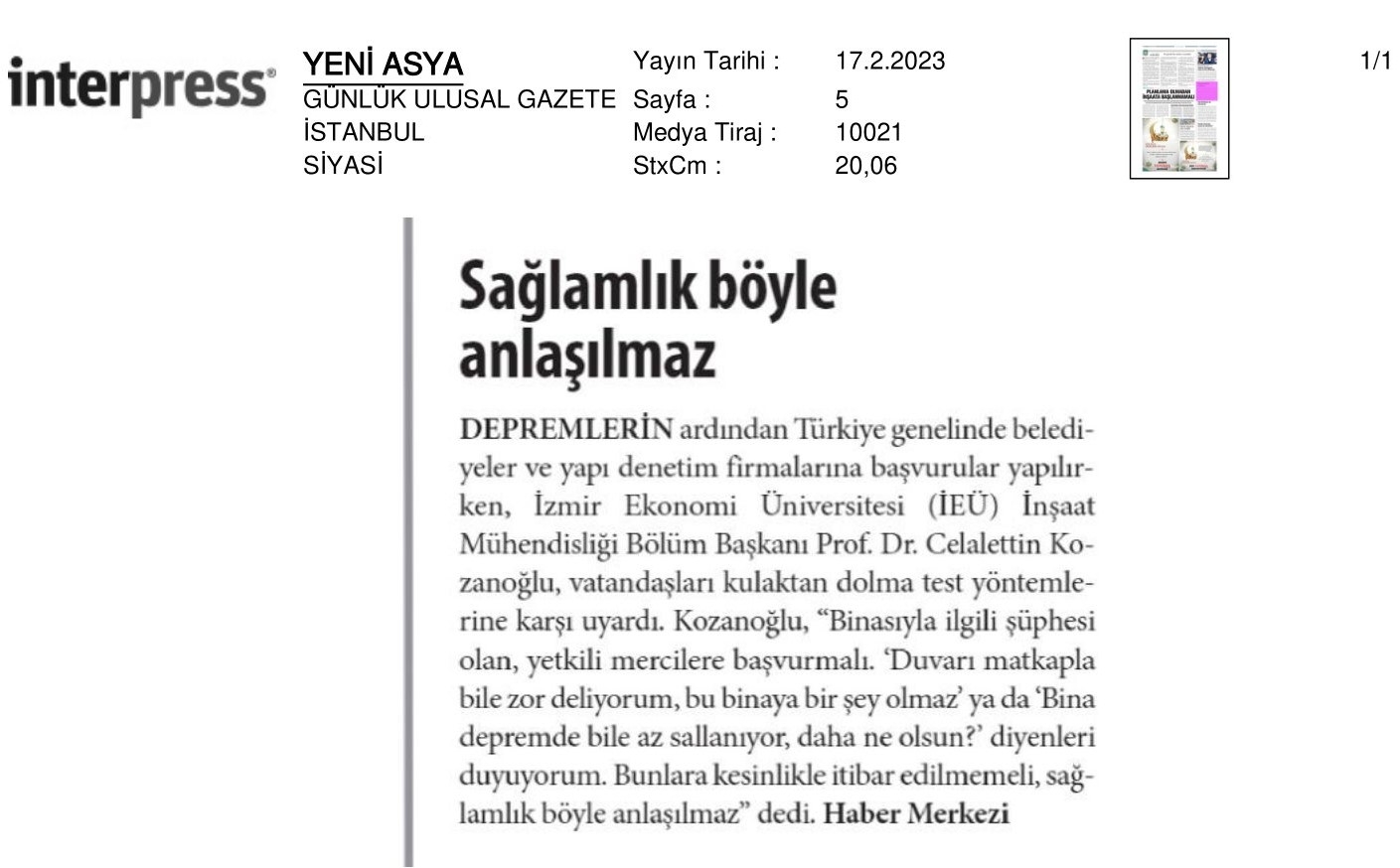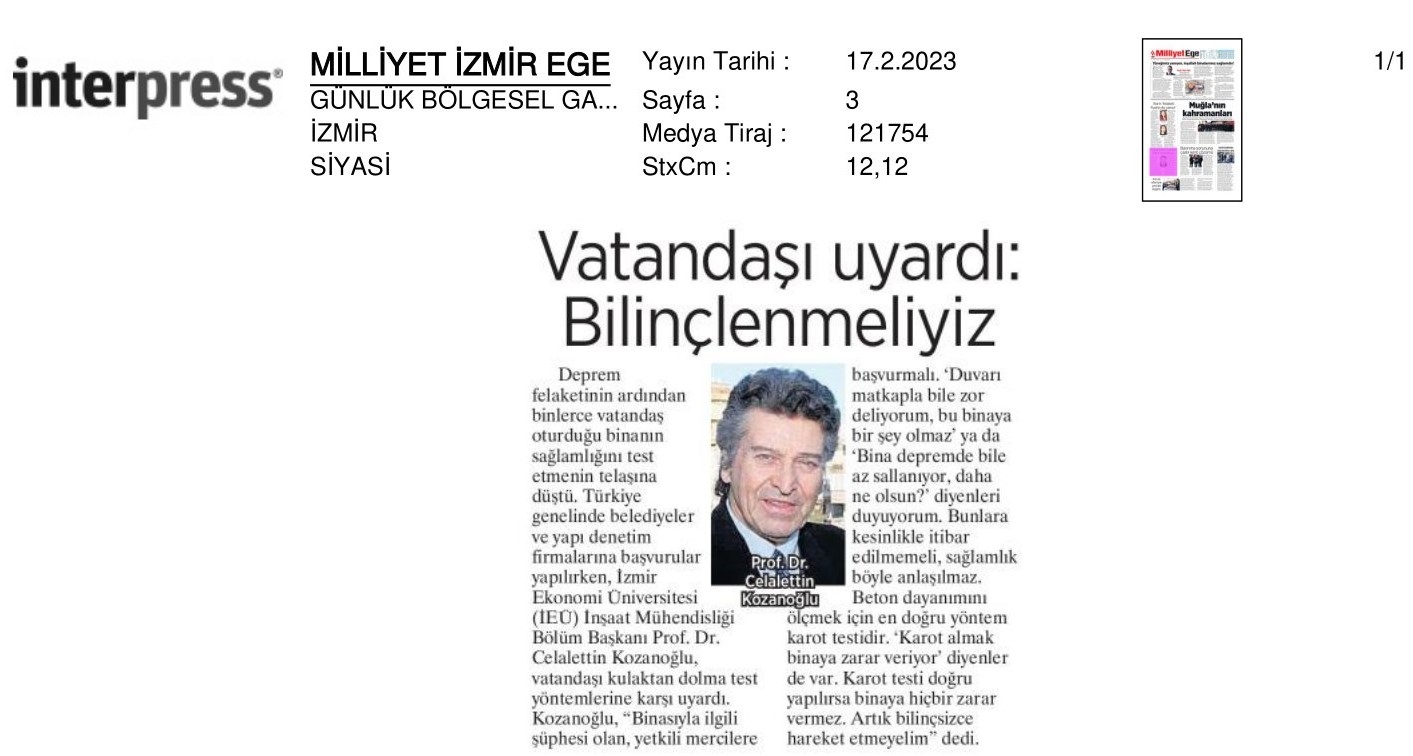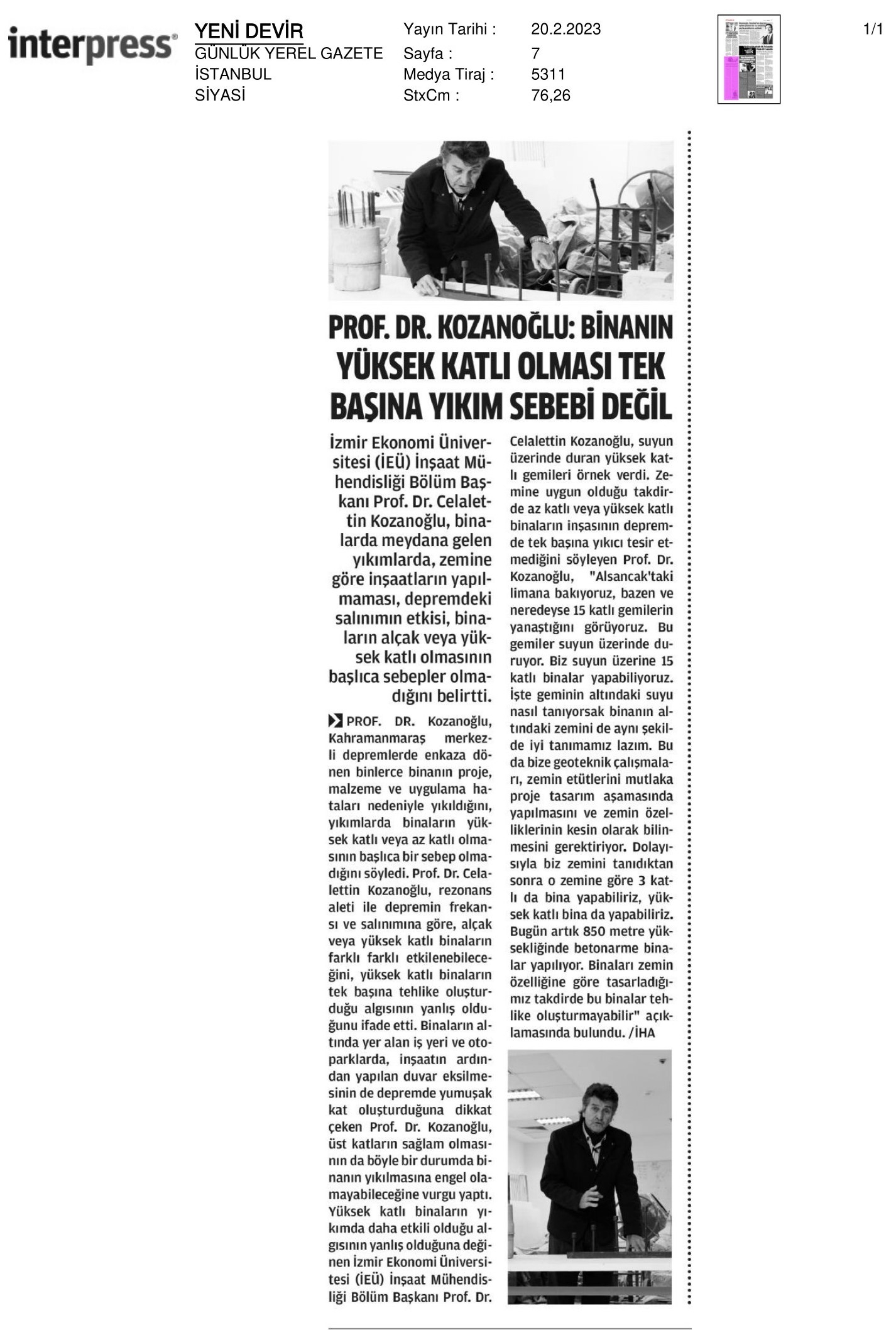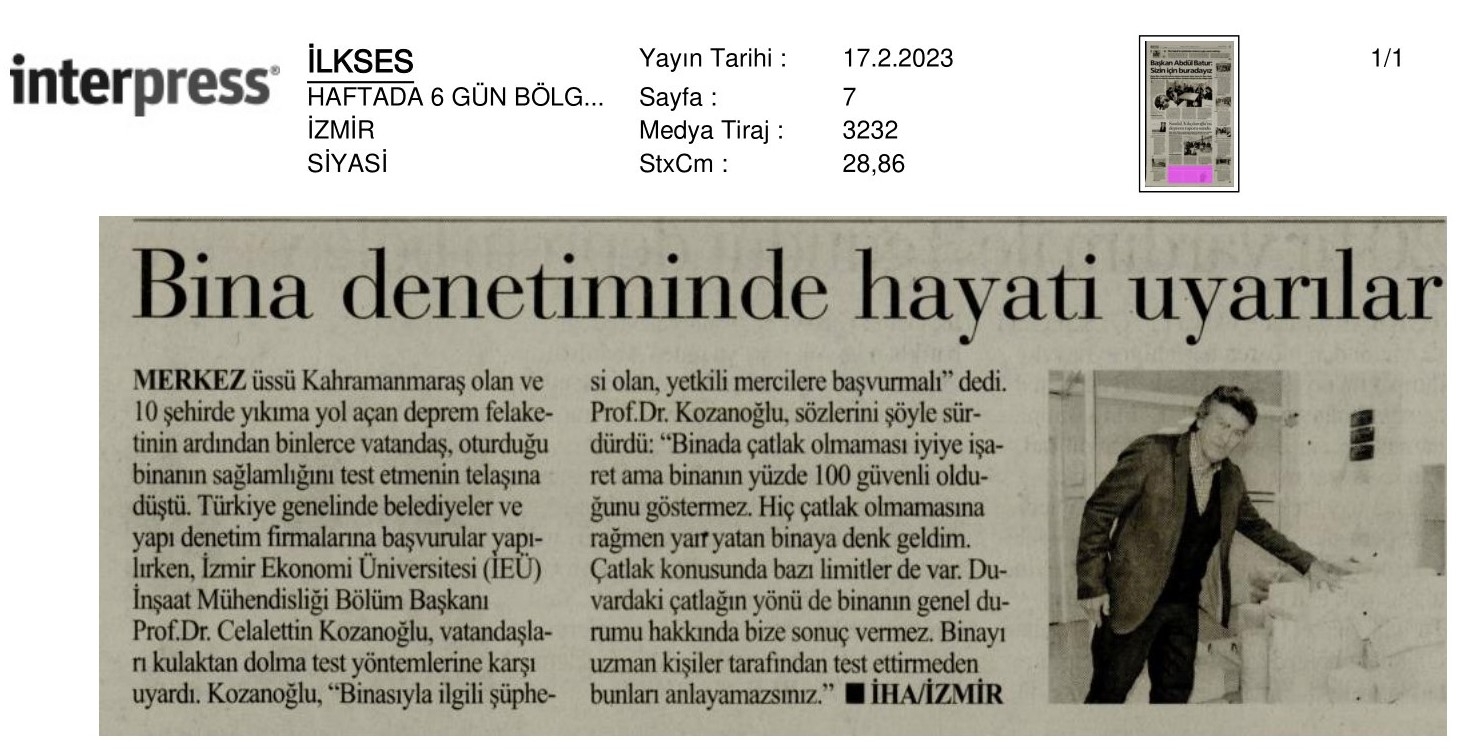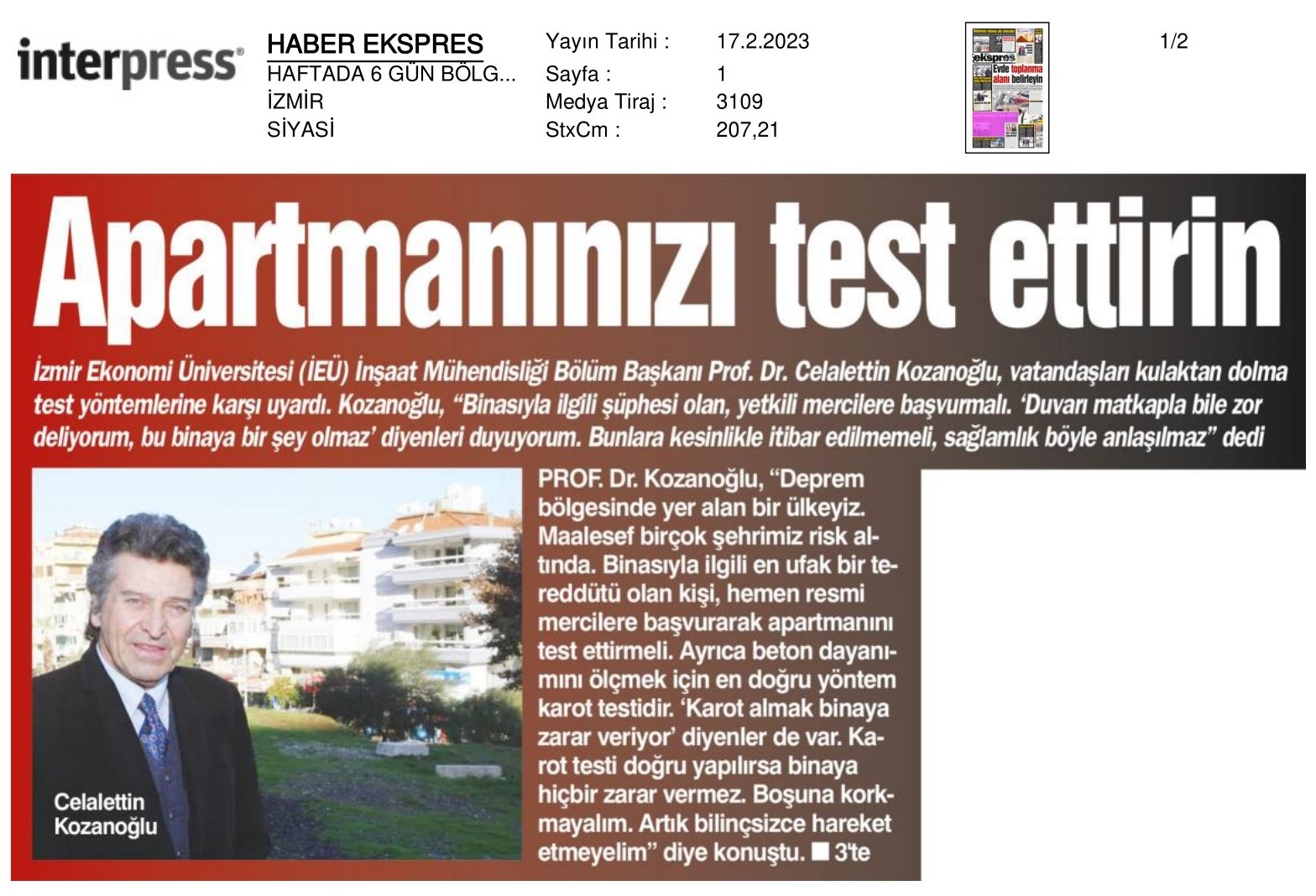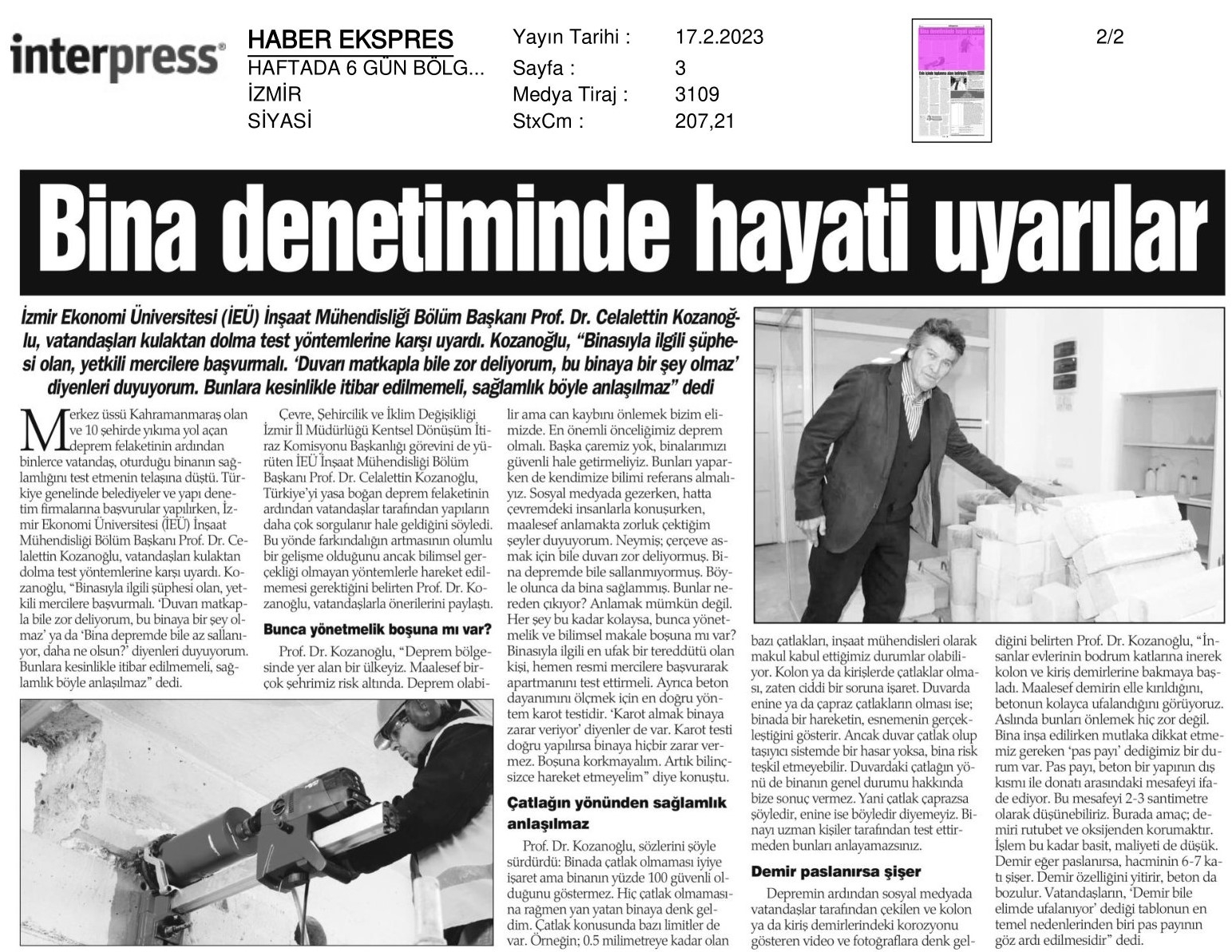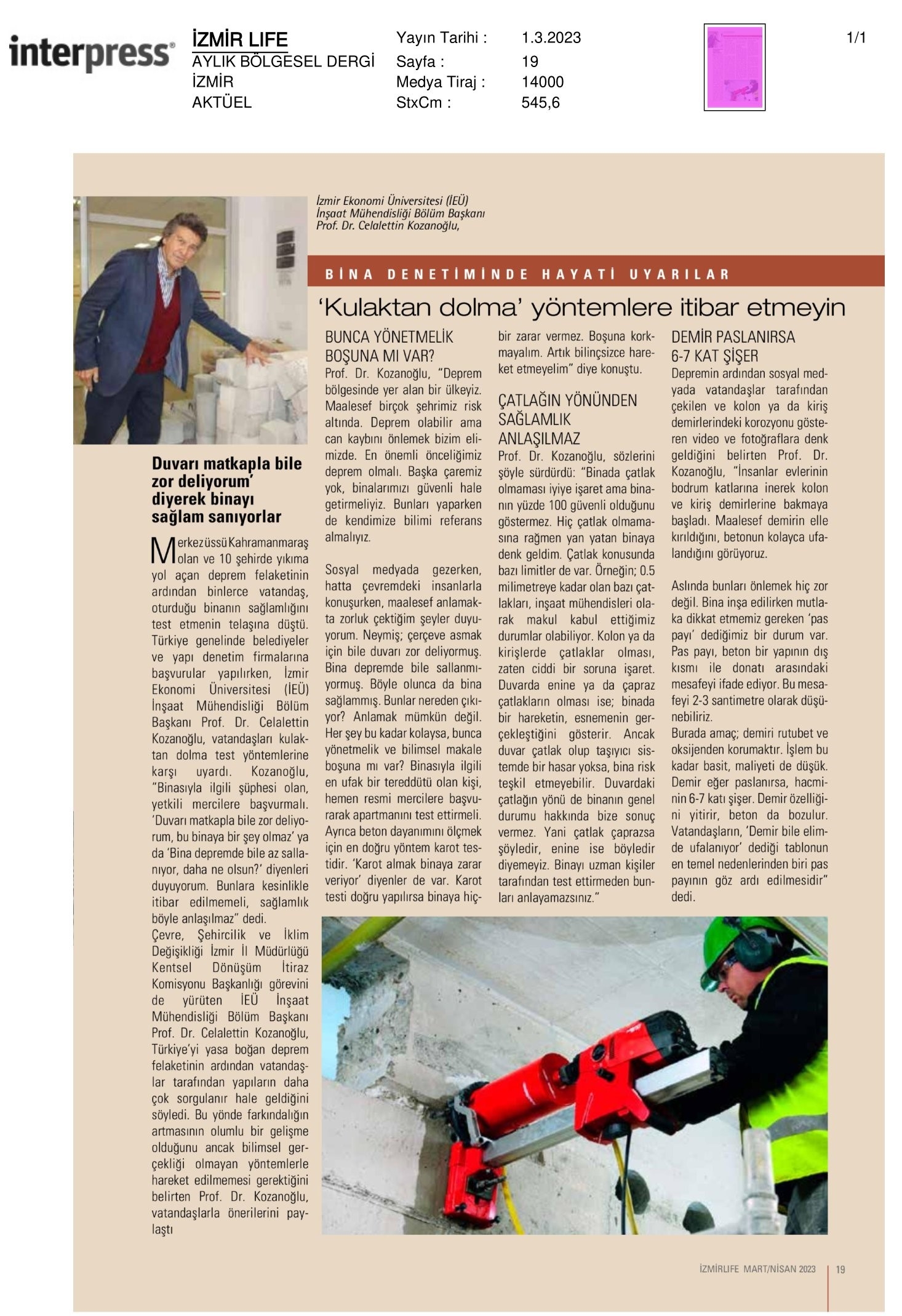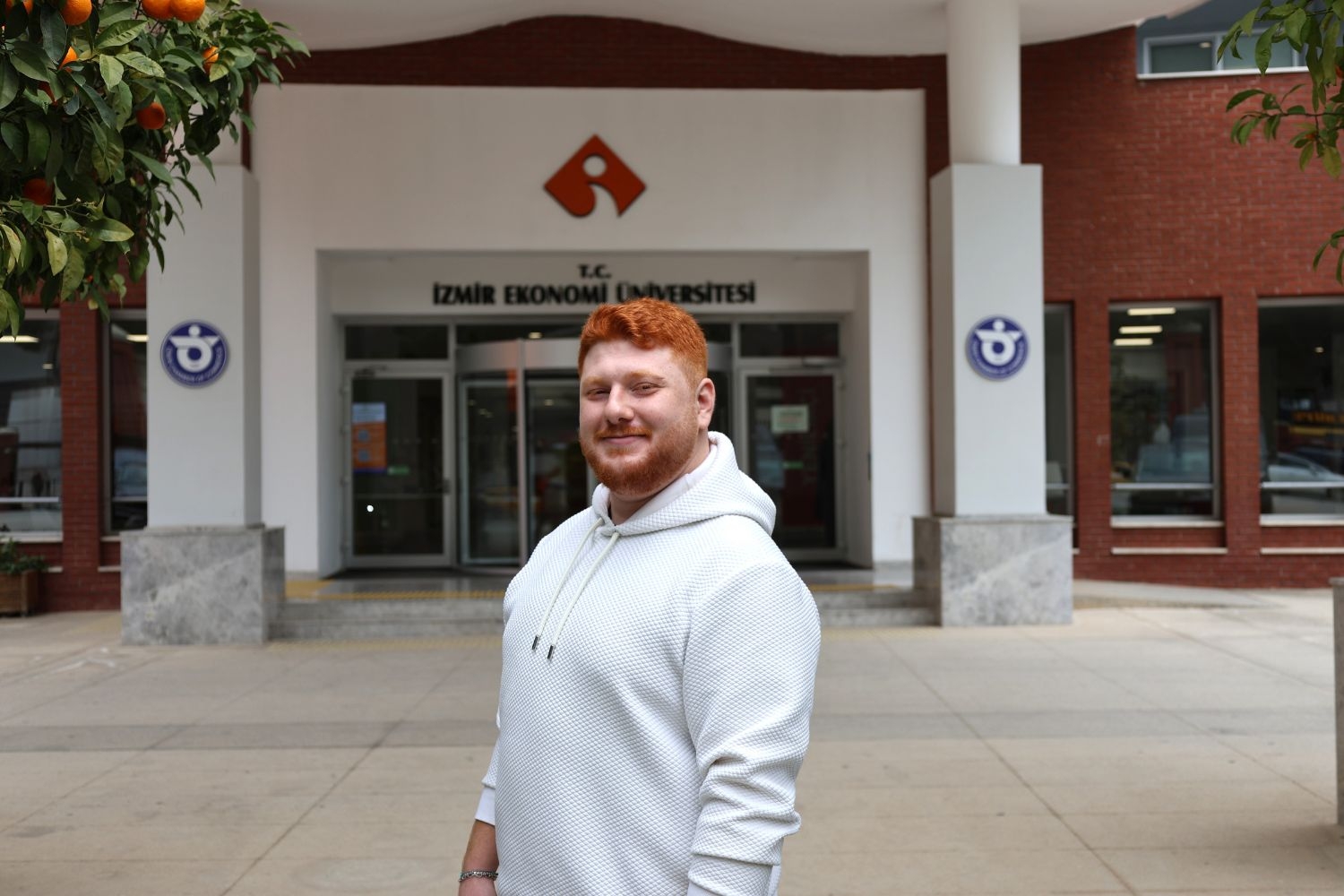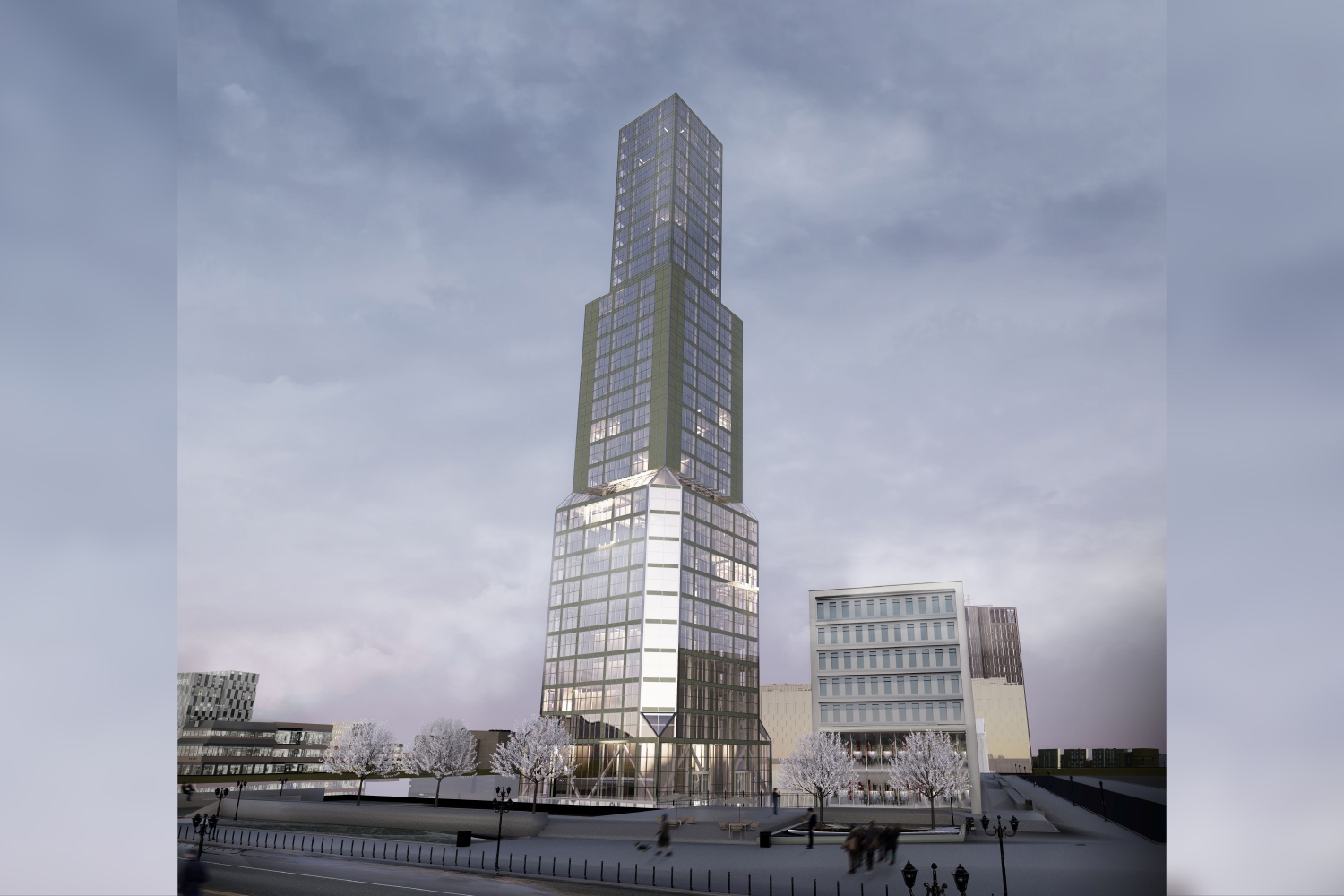Vital warnings in building inspections
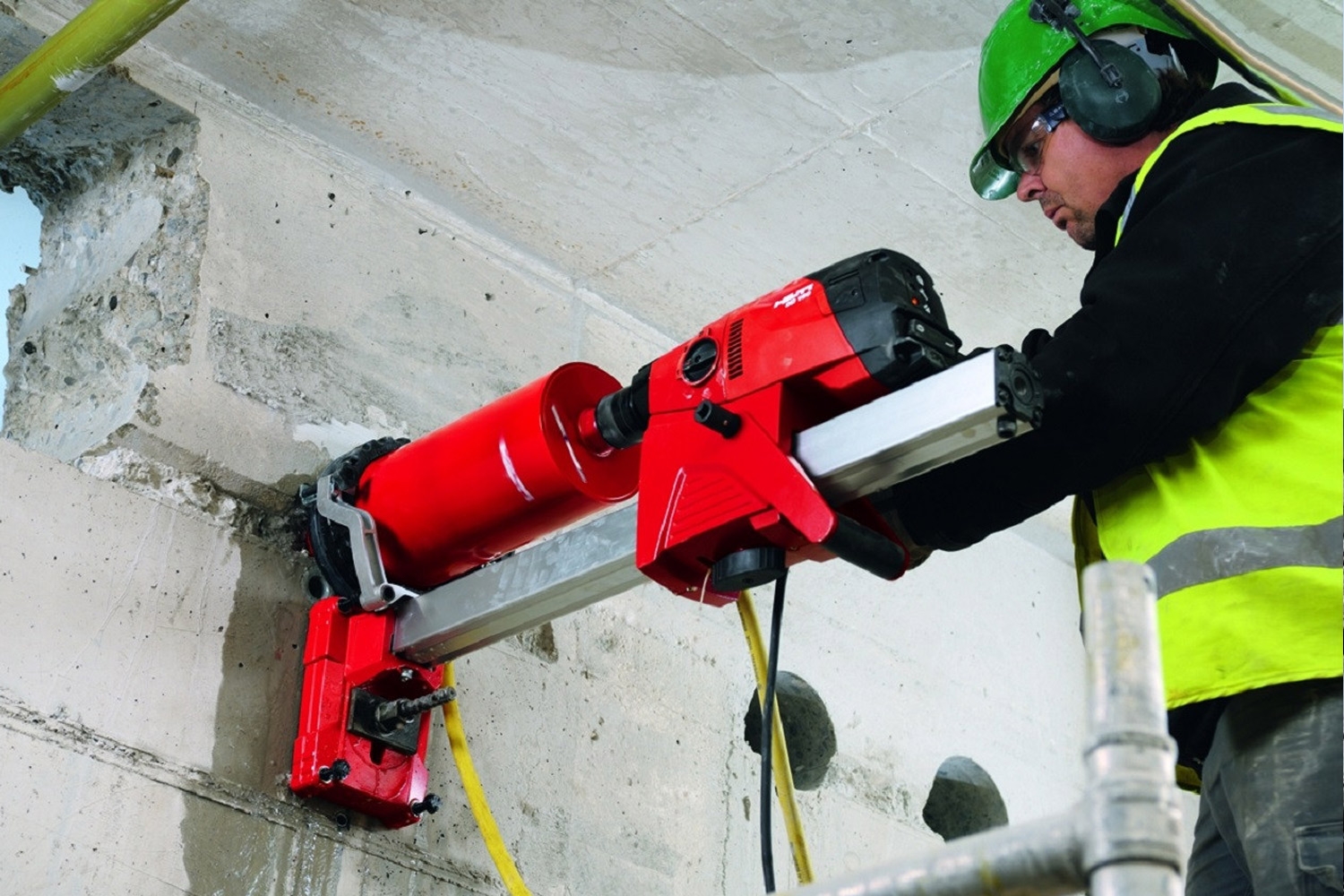
After the earthquake disaster, the epicenter of which was Kahramanmaraş and which caused destruction in 10 cities, thousands of citizens rushed to test the robustness of the building they live in. While applications are made to municipalities and building inspection companies throughout Turkey, Izmir University of Economics (IUE) Civil Engineering Department Head Prof. Dr. Celalettin Kozanoğlu, Head of Department of Civil Engineering, Izmir University of Economics (IUE), warned citizens against hearsay test methods. Kozanoğlu said, “Anyone who has doubts about their building should contact the competent authorities. I hear people saying, ‘I can hardly drill the wall with a drilling machine, nothing will happen to this building’ or ‘the building shakes a little even in an earthquake, what else?’ These should not be trusted, robustness cannot be understood like this.”
Chairing also the Urban Transformation Appeals Commission of Provincial Directorate of Environment, Urbanization and Climate Change, Prof. Dr. Celalettin Kozanoğlu stated that the buildings became more questionable by the citizens after the earthquake disaster that saddened Turkey deeply. Emphasizing that increasing awareness in this direction is a positive development, Prof. Dr. Kozanoğlu shared his suggestions with the citizens.
ARE ALL THESE REGULATIONS FOR NOTHING?
Prof. Dr. Kozanoğlu said, “We are a country located in an earthquake zone. Unfortunately, many of our cities are at risk. There may be an earthquake, but it is in our hands to prevent loss of life. Earthquake should be our top priority. We have no other choice, we must secure our buildings. While doing these, we should take science as a reference. While surfing social media or even talking to people around me, I unfortunately hear things that I have trouble understanding such as them having difficulty to drill into the wall even to hang a frame, or that their building doesn’t even shake in an earthquake. Coming to a conclusion that the building is intact. Where do these come from? It is impossible to understand. If everything is that easy, are all the regulations and scientific articles for nothing? Anyone who has the slightest hesitation about their building should immediately apply to the official authorities and have it tested. In addition, the most accurate method to measure concrete strength is the drilled core test. There are also those who say, ‘Taking a core damages the building’. If the core test is done correctly, it will not cause any damage to the building. Let's not be afraid for nothing. Let's not act ignorantly anymore.”
ROBUSTNESS CANNOT BE UNDERSTOOD BY THE DIRECTION OF A CRACK
Prof. Dr. Kozanoğlu continued as follows: “The absence of cracks in the building is a good sign, but it does not indicate that the building is 100 percent safe. I came across raking in buildings, although there were no cracks. There are also some limits on cracking. For example, there are situations where we, as civil engineers, consider some cracks up to 0.5 millimeters reasonable. Cracks in columns or beams already indicate a serious problem. If there are transverse or diagonal cracks on the wall; it shows that a movement, a stretching has taken place in the building. However, if the wall is cracked and there is no damage to the bearing system, the building may not pose a risk. The direction of the crack in the wall does not give us any result about the general condition of the building. In other words, we cannot say that if the crack is diagonal it is like this, and if it is transverse it is like that. You cannot understand them without having the building tested by experts.”
IF THE IRON RUSTS IT SWELLS UP TO 6-7 TIMES
Stating that he saw videos and photos taken by the citizens on social media after the earthquake, showing the corrosion in the column or beam irons, Prof. Dr. Kozanoğlu said, “People started to go down to the basements of their homes and began to inspect the columns and beams. Unfortunately, we see that the iron is broken by hand and the concrete crumbles easily. Actually, it is not difficult to avoid these at all. There is a situation we call the ‘concrete cover’ that we must pay attention to when constructing the building. It refers to the distance between the exterior of a concrete structure and the reinforcement. We can think of this distance as 2-3 centimeters. The purpose here is to protect the iron from moisture and oxygen. The process is that simple and the cost is low. If iron rusts, it swells 6-7 times its volume. Iron loses its property, concrete also deteriorates. One of the main reasons for the statement, where citizens say, ‘Even the iron is crumbling in my hands’ is the ignoring of the concrete cover.”
Press Clippings
NEWSALL NEWS

Italian National Space Day Workshop
The Italian National Space Day Workshop was successfully held on December 16, 2024, by the Aerospace Engineering Department of Izmir ...

The 3-week Bioinformatics Bootcamp
The 3-week Bioinformatics Bootcamp, organized by our university's IEEE EMBS and CS student branches, has been successfully completed. Research Assistant ...

Izmir University of Economics Information Technologies Hackathon Event
Izmir University of Economics IT Hackathon was held on 21-22 December 2024 with the participation of 22 of our students ...
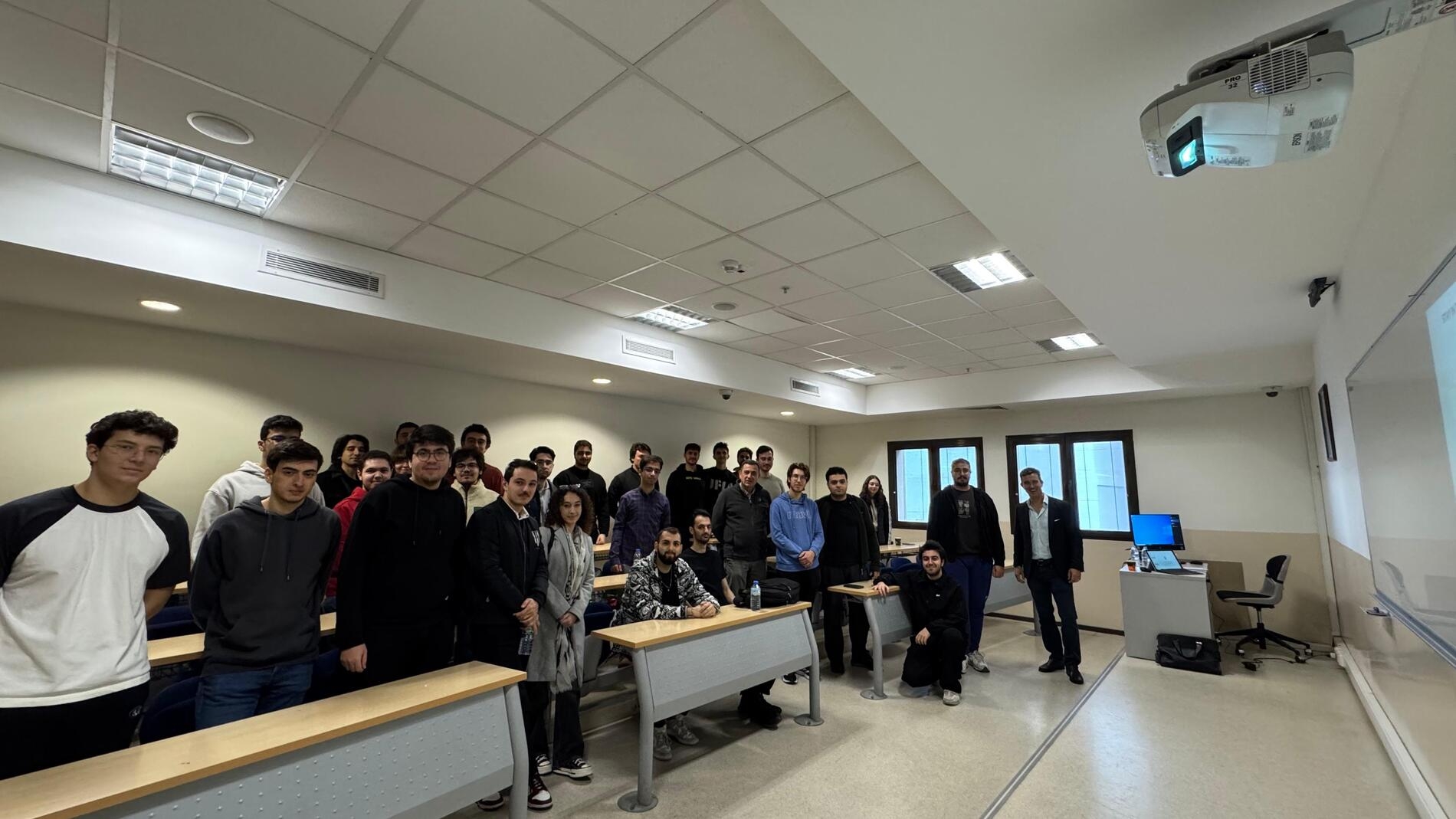
Visit of broadAngle in Izmir University of Economics
Garrison Atkisson, co-founder and CEO of broadAngle, a software company operating in the US and Izmir, and Nihatcan Çolpan, a ...

NEW GÜZELBAHÇE CAMPUS
DetailsGLOBAL CAREER
As Izmir University of Economics transforms into a world-class university, it also raises successful young people with global competence.
More..CONTRIBUTION TO SCIENCE
Izmir University of Economics produces qualified knowledge and competent technologies.
More..VALUING PEOPLE
Izmir University of Economics sees producing social benefit as its reason for existence.
More..



